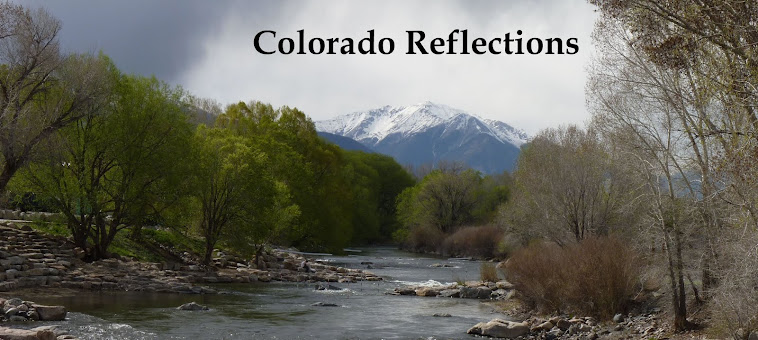 |
| Cash Creek Photo by W.G. Chamberlain Denver Public Library Digital Collections |
 |
| Photo by Gayle Gresham |
The only known photo of the Cash Creek mining camp is the photo by W.G. Chamberlain between 1865 and 1875 in the Denver Library Digital Collections. Wilburn Christison, my great-great-grandfather, lived with his wife and six children at Cash Creek between 1861 and 1865 or so. He had a trading post with the Ute Indians and prospected and engaged in mining enterprises.
Today my husband figured out where W.G. Chamberlain took his photo by looking at the mountains. And I hiked to approximately the same spot and took a photo. The photos look at Cash Creek (Cache Creek) from the southwest hill. At the center of each photo is a road that curves. This is at the Granite Cemetery. The three trees in today's photo are near the cemetery.
The ditch, is what I believe is the Cash Creek Ditch, engineered by Henry Justice, who also supervised the digging in 1861 to bring the water from the Twin Lakes. Wilburn Christison was a shareholder in the project.
The terrain has changed quite a bit by natural erosion (I believe that is why the road isn't as prominent in today's photo) and by hydraulic mining where the gravel was washed away by hydraulic nozzles. As you can see, there is quite a change in the level where the trees are and the same level in Chamberlain's photo.
But, I was fascinated to see that the trail to walk down to the creek is about the same.
Here's a photo of Cache Creek from the west on an overlook on Lost Canyon Road. You can see the craters created by the hydraulic mining.
To learn more about early Cash Creek, look for my chapter, "The Cash Creek Miners and the Lake County War," in Rush to the Rockies, a book of papers presented at the Pikes Peak Library District's Regional History Symposium and published by the Pikes Peak Library District.
Additional Blog Posts Relating to Cash Creek and the Christison Family:
Cache Creek or Cash Creek
The Death of Judge Christison
Elizabeth Jane Christison - Colorado Pioneer
My Cache Creek Gold Panning Experience





